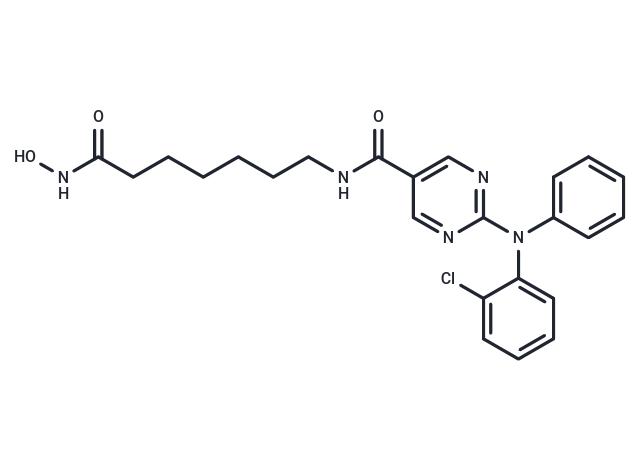Shopping Cart
- Remove All
 Your shopping cart is currently empty
Your shopping cart is currently empty

ACY-241, also known as Citarinostat (ACY241), is a potent, selective and orally available histone deacetylase (HDAC) inhibitor, with potential antineoplastic activity. Upon oral administration, ACY-241 inhibits the activity of HDACs; this results in an accumulation of highly acetylated chromatin histones, the induction of chromatin remodeling and an altered pattern of gene expression. This leads to the inhibition of tumor oncogene transcription, and the selective transcription of tumor suppressor genes, which inhibit tumor cell division and induce tumor cell apoptosis.

| Pack Size | Price | Availability | Quantity |
|---|---|---|---|
| 1 mg | $44 | In Stock | |
| 5 mg | $97 | In Stock | |
| 10 mg | $122 | In Stock | |
| 25 mg | $222 | In Stock | |
| 50 mg | $372 | In Stock | |
| 100 mg | $538 | In Stock | |
| 1 mL x 10 mM (in DMSO) | $98 | In Stock |
| Description | ACY-241, also known as Citarinostat (ACY241), is a potent, selective and orally available histone deacetylase (HDAC) inhibitor, with potential antineoplastic activity. Upon oral administration, ACY-241 inhibits the activity of HDACs; this results in an accumulation of highly acetylated chromatin histones, the induction of chromatin remodeling and an altered pattern of gene expression. This leads to the inhibition of tumor oncogene transcription, and the selective transcription of tumor suppressor genes, which inhibit tumor cell division and induce tumor cell apoptosis. |
| Targets&IC50 | HDAC3:46 nM, HDAC1:35 nM, HDAC2:45 nM, HDAC7:7300 nM, HDAC6:2.6 nM, HDAC8:137 nM |
| In vitro | In cell lines from multiple solid tumor lineages, combination treatment with ACY-241 and paclitaxel enhances inhibition of proliferation and increases cell death relative to either single agent alone. Combination treatment with ACY-241 and paclitaxel also results in more frequent occurrence of mitotic cells with abnormal multipolar spindles and aberrant mitoses, and is associated with increased frequency of abnormal multipolar mitotic spindle formation, induction of aneuploidy, and increased cell death. In A2780 ovarian cancer cells, 24 hour treatment with 300 nM ACY-241 results in increased hyperacetylation of α-tubulin, consistent with inhibition of the tubulin deacetylase HDAC6. Low exposures of ACY-241 result in selective inhibition of HDAC6, while higher exposures lead to inhibition of Class I HDAC isozymes[1]. |
| In vivo | ACY-241 has a favourable safety profile than non-selective pan-HDAC inhibitors. It has the potential for a substantially reduced side effect profile versus current nonselective HDAC inhibitor drug candidates due to reduced potency against Class I HDACs while retaining the potential for anticancer effectiveness[1]. |
| Cell Research | A2780 cells are cultured with vehicle or a range of ACY-241 concentrations for 24 hours prior to immunoblotting.(Only for Reference) |
| Alias | HDAC-IN-2, ACY241 |
| Molecular Weight | 467.95 |
| Formula | C24H26ClN5O3 |
| Cas No. | 1316215-12-9 |
| Smiles | ONC(=O)CCCCCCNC(=O)c1cnc(nc1)N(c1ccccc1)c1ccccc1Cl |
| Relative Density. | 1.293 g/cm3 (Predicted) |
| Storage | Powder: -20°C for 3 years | In solvent: -80°C for 1 year | Shipping with blue ice. | ||||||||||||||||||||||||||||||
| Solubility Information | DMSO: 37 mg/mL (79.07 mM), Sonication is recommended. | ||||||||||||||||||||||||||||||
Solution Preparation Table | |||||||||||||||||||||||||||||||
DMSO
| |||||||||||||||||||||||||||||||

Copyright © 2015-2025 TargetMol Chemicals Inc. All Rights Reserved.